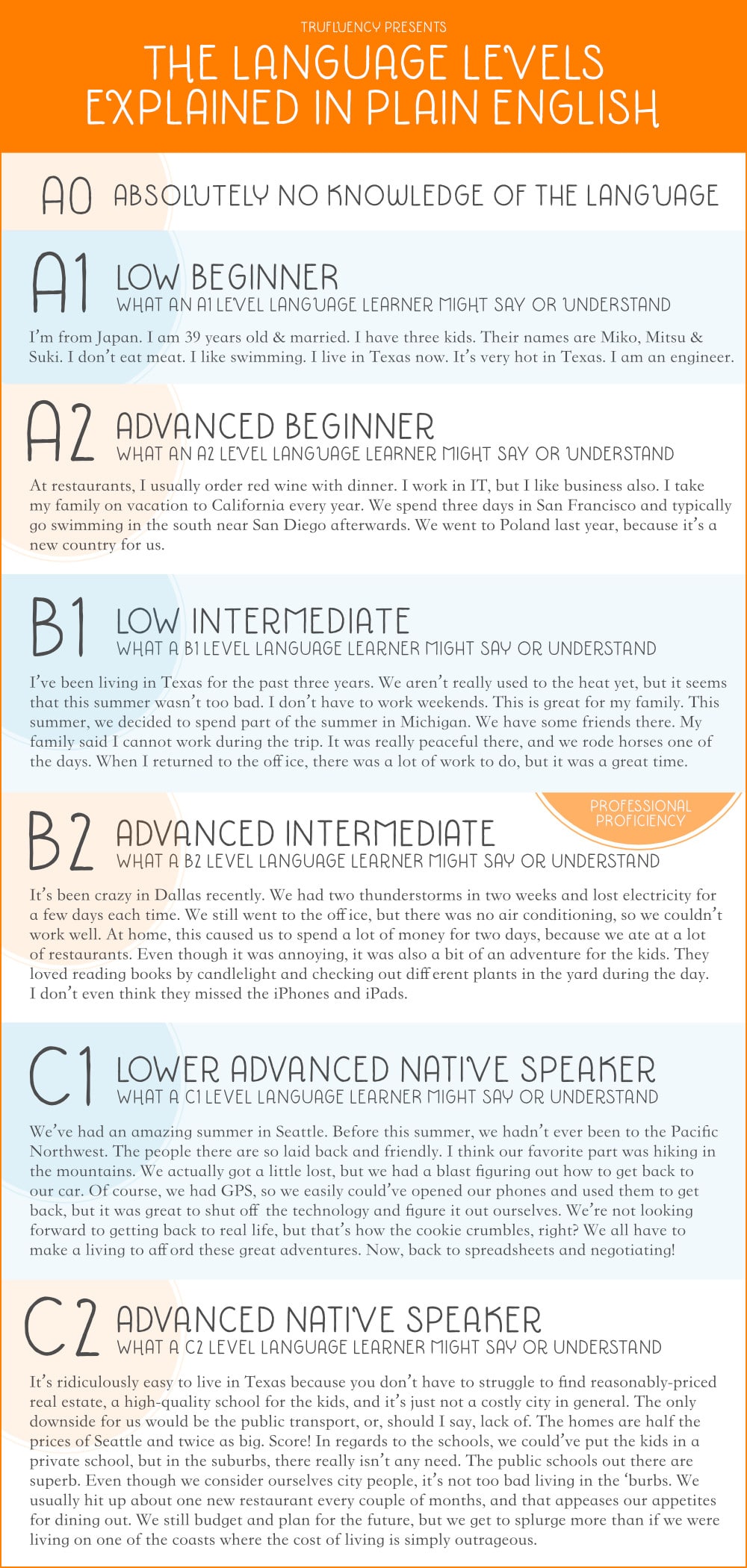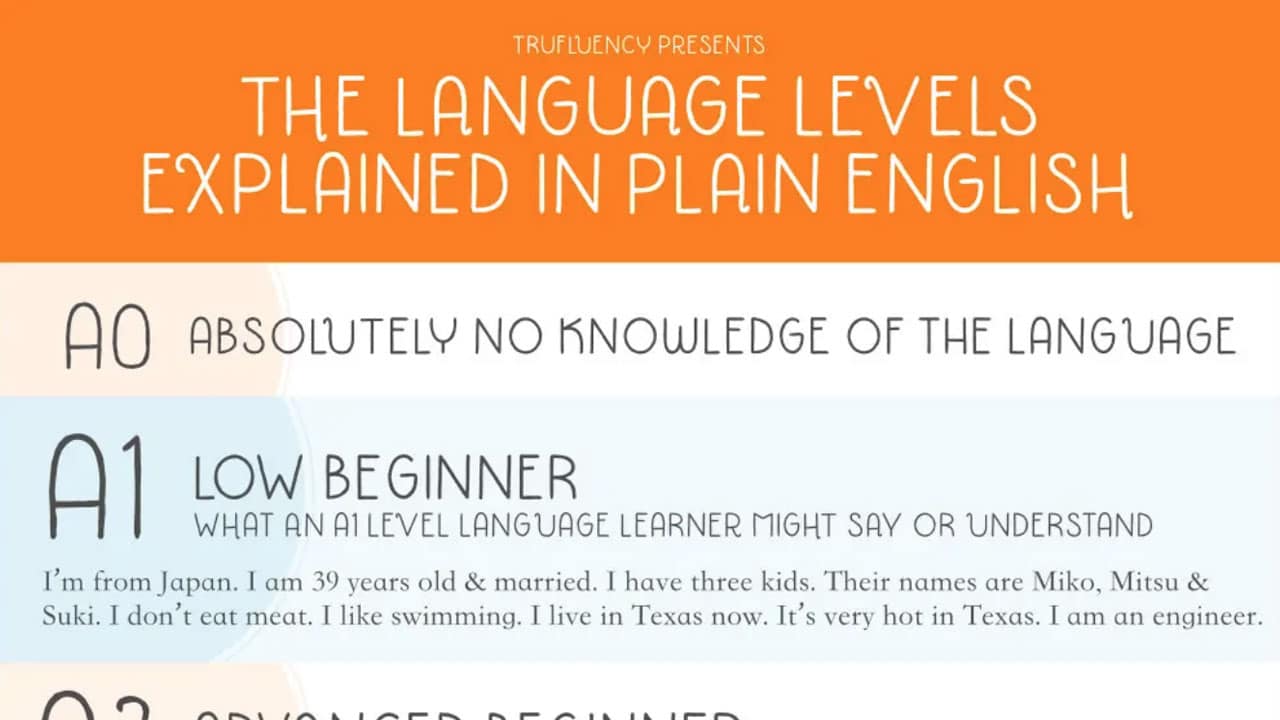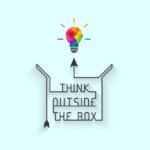Common European Framework of Reference for Languages (CEFR)
At TruFluency, we like to use the CEFR to determine language levels. If you’re unfamiliar with it, the CEFR was developed in Europe and it has six levels which we’ll go into. According to an article, “Rather than being tied to a particular test, the CEFR is a collection of can-do statements that list the functions you will be able to perform using a foreign language at any given level of proficiency”. Let’s get into the levels.
Here is a breakdown of the language levels and what you’ll be able to say:

Let’s summarize the information.
A0
At this level, you won’t know anything about the language. In order to progress to the next level you’ll definitely need to start learning the basics of the language. You can start with simple phrases that you’ll need to make an introduction and speak about yourself.
A1-Low Beginner
To get to this level, you’ll need between 100-150 hours. Mastering this level means you can talk a little about yourself in the target language. You’ll be able to tell people your name, age, likes and dislikes using simple sentences.
A2-Advanced Beginner
At this level you will be able to communicate at work if you work in a factory, farm or other manual jobs. You’ll be able to talk about yourself more in-depth using more complex sentences. You’ll need 180-200 hours to get here.
B1-Low Intermediate
According to English Profile, you’ll be able to “communicate essential points and ideas in familiar contexts” when you achieve this level. Approximately 350–400 hours could help you to get here.
B2-Advanced Intermediate
At this level and the level above you’ll be able to work at a hotel, restaurant etc. You’ll some level of fluency at this level and have more in-depth conversations.
You may need around 500–600 hours to get here.
C1-Lower Advanced Native Speaker
At this level, you’ll be able to speak more fluently and flexibly. This will take about 700-800 hours.
C2-Mastery
This level is where you’ll be able to read and speak pretty much anything in the target language. It may take about 1000-1200 hours to reach here.
NB the hours listed here were listed for English proficiency.
How do I know my language level?
There are standardized ways of figuring out your language level. You can do proficiency tests such as:
- DEFL – (Diploma in French Language Studies) French
- DELE – (Diplomas en Español) Spanish
- JPLT – Japanese Language Proficiency Test
- TOEFL – Test of English as a Foreign Language for Academic English
- TOEIC – The Test of English for International Communication for Business English
For example, the DELE covers Spanish levels. It’s suggested that you keep doing the same test as you complete your language learning journey so that you’re able to make an accurate comparison. You also don’t have to do language tests. Some universities and jobs may require a specific test but if you’re just doing learning a second language to become bilingual for more personal reasons then you can skip the tests. Remember also that these tests are academic tests and measure your academic level of the language, you can definitely be able to speak a language and not do great on a test.
How to move from one language level to the next
As mentioned in the previous section, you’ll need to put in a certain number of hours to move from one language level to the next. You’ll need to get as many contact hours with the language as you can. Naturally, there are some activities that will help you to advance a bit quicker than others, you can still fit in other activities. Let’s look at some ways you can do that.
Consume media in your target language
This includes Netflix, YouTube videos, and books. It’s important to note that it does depend on what you do with your time. That means that an hour watching the tv without subtitles really counts for about 45 minutes of language contact time. A better use of your time would be to watch the show WITH subtitles because you’ll be developing both listening and reading skills.
Put language learning in your schedule
Wishing you are fluent in a second language won’t make you fluent, it requires lots of hours. Most of us want more hours in our day anyway so to make sure you have time for language learning you’ll have to make time. Put in your schedule or planner dedicated hours for language learning, set timers or reminders, and ask your support system to remind you.
Hire a language tutor or a couple
Language tutors should be able to provide valuable contact time with the language. Conversation with your tutor for an hour speaking and practicing the language is a great way to spend your hour and is bringing you one step closer to your language learning.
If you’re looking for a language tutor who can work with you to help you get fluent or fluent enough for your goal, check us out, we are offering 20% off the first month’s subscription with code TF20!





